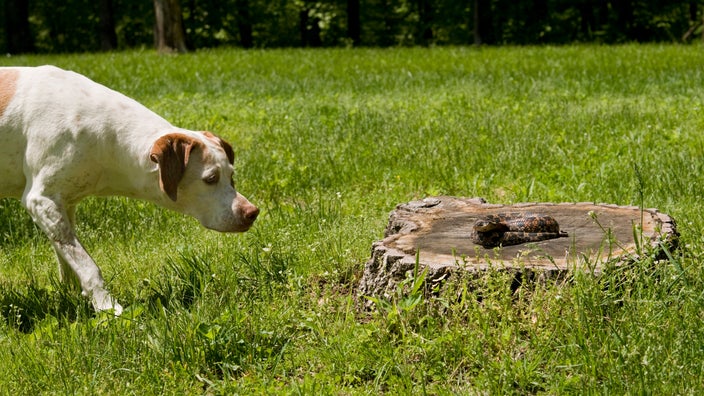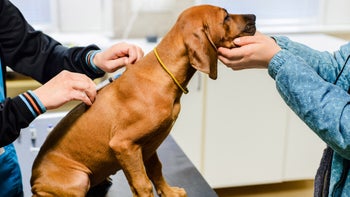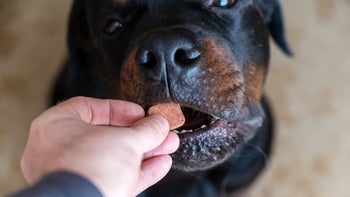
Your Dog Got Bitten by a Snake. What Should You Do Now?
Key takeaways:
It’s not uncommon for dogs to get bitten by a snake, especially if you live in areas with a large snake population.
Venomous snake bites are life-threatening to dogs and need prompt treatment.
Taking the right steps and quickly getting your dog to the veterinarian can improve their prognosis after a bite.

Dogs are naturally curious and love to explore, but that can lead to trouble if they come across a snake. Venomous snake bites can be life-threatening for your dog. An estimated 150,000 dogs and cats are bitten each year. Immediately getting your dog the treatment they need can increase their chances of survival.
In this article, we’ll cover how you can tell if your dog has been bitten by a snake, what you should do, and what to expect for their recovery.
How do you know if your dog has been bitten by a snake?
If your dog is bitten by a snake and you didn’t see it happen, you may notice certain signs. The symptoms of a snake bite will depend on whether the snake was venomous. Symptoms can also vary depending on the type of snake. You might notice any of the following:
Weakness
Collapse
Vomiting
Diarrhea
Muscle twitching and trembling
Unsteady gait
Drooling
Bleeding from the nose
Discolored urine due to kidney failure
Low blood pressure
Shock
Search and compare options
Dr. Carol Osborne, a veterinarian who owns Chagrin Falls Veterinary Center & Pet Clinic in Ohio, notes that you may see swelling in the bite area. You could see two small punctures from the snake’s fangs. Usually, though, the bite is beneath your dog’s hair.
What to do when your dog is bitten by a snake
Once you realize your dog was bitten by a snake, take them for emergency veterinary care right away. Don’t wait for symptoms to appear and go even if you think the snake was not venomous. If you’re not positive the snake was non-venomous, then always assume it was venomous.
Dr. Osborne recommends taking the following steps:
Don’t panic. You need to act quickly but also need to keep your dog calm, too.
Call your vet or your local emergency clinic and let them know that you’re on your way. Dr. Osborne notes that vets don’t all have antivenom on hand. You may need to call around to different emergency facilities to find the best place to go. Give your vet as much head notice as possible so they’re prepared for your arrival.
Minimize your dog’s movement and help them stay calm. Carry them to your car and into the emergency animal hospital. If you can, prevent the part of your dog’s body that was bitten from moving and keep it below their heart. If you can’t easily or quickly do this, prioritize getting them to the vet’s office.
If your dog was bitten on the face, remove their collar. This can help your dog breathe if their neck swells.
If you saw the snake bite your dog, try to identify the snake or make note of as many of its features as possible. If you can safely take pictures of the snake to bring to the vet, do so. Those photos can help to identify the snake and the appropriate antivenom.
Follow any additional instructions your vet may give you to help your dog while you’re on your way to the clinic or emergency hospital.
How do vets treat a snake bite?
Your dog’s snake bite treatment will depend on many factors. The size and species of the snake and the location of the bite are important. Your dog’s age and size can also affect the treatment they need.
Your vet may clean the bite and give your dog antibiotics and antihistamines. Some dogs may need fluids and might need to be treated for shock. Your vet may administer antivenom if the bite was venomous.
Antivenom treatment is expensive. It can cost around $450 per vial for the antivenom itself. Your dog may need several vials of antivenom as well as close monitoring and bloodwork to make sure they’re responding to treatment. Some dogs need blood or plasma transfusions, too.
Read more like this
Explore these related articles, suggested for readers like you.
Depending on the severity of the bite, your dog may need to be hospitalized for a day or two. This allows the vet to carefully monitor your dog and continue treatment. When you arrive home, be sure to carefully monitor your dog and call your vet if the wound doesn’t improve.
Can dogs survive a snake bite without treatment?
Dogs bitten by non-venomous snakes may be fine with minimal supportive treatment. These bites typically cause swelling and bruising. They can become infected, so it’s important to monitor your dog. A vet visit is still recommended.
Venomous bites are life-threatening medical emergencies. Up to 30% of dogs bitten by a venomous snake will die. Factors like the number of bites, their location, and the size of your dog can affect the dog’s survival.
In cases where a bite from a native North American snake is treated effectively, a dog’s prognosis is usually good. Some dogs may have long-term complications, depending on the type of venomous snake bite. Your vet will help you understand what to expect with your dog.
How do you prevent future snake bites?
You can take steps to minimize the chance of your dog being bitten by a snake by being aware of your environment.
“Snakes are nocturnal, so hike during the day,” Dr. Osborne says. “Snakes feed primarily on rodents, so stay away from wood piles. Trim long grass and brush by your house, since these are hiding spots for snakes. Don’t leave garbage around or do anything that would attract rats and mice.”
If you live in or are traveling through an area with a venomous snake population, you’ll need to be extra cautious. “Do your homework,” Dr. Osborne adds. “Don’t just go hiking in an area. You need to know what you’re getting yourself into.”
You can use this interactive map to determine what snakes live in your state and any state you will be visiting. Research suggests that the majority of snake bites occur in the U.S. Southwest. This includes states such as:
Arizona
New Mexico
Nevada
Oklahoma
Texas
Utah
Dr. Osborne recommends that dog owners call local veterinarian facilities ahead of time. Find out which facilities have antivenom on hand. Then, make a plan so you’ll know what to do and where to go if your dog is bitten.
In areas with large populations of venomous snakes, you can often find snake avoidance training classes for dogs. Like other types of dog training, you’ll use positive reinforcement to teach your pup to recognize and run away from snakes.
The bottom line
If a snake bites your dog — especially if the snake may be venomous — you need to act quickly. Call the nearest emergency animal hospital to let them know you’re coming. Keep your dog calm and quiet as you travel. The vet can help determine an appropriate treatment plan. Carefully supervising your dog and choosing where you take them for walks can reduce the chance of encountering a snake. Hopefully, your dog will never be bitten by a snake. But it’s important to be prepared.
Why trust our experts?



References
Broadway Veterinary Hospital. (n.d.). Dog rattlesnake bite treatment.
Chagrin Falls Veterinary Center & Pet Clinic. (n.d.). Chagrin Falls veterinary center & pet clinic.
CroFab. (n.d.). Snakes in your state.
Gfeller, R., et al. (2018). Snakebite: First aid. Veterinary Partner.
Gilliam, L. L., et al. (2011). North American snake envenomation in the dog and cat. Veterinary Clinics of North America: Small Animal Practice.
Gwaltney-Brant, S. M. (2022). Snakebites in animals. Merck Veterinary Manual.
Pet Companion Magazine. (2020). Protect your dog with snake avoidance training.
Walden, L. A. (2016). Snakebite in animals: A brief refresher. American Veterinarian.





























